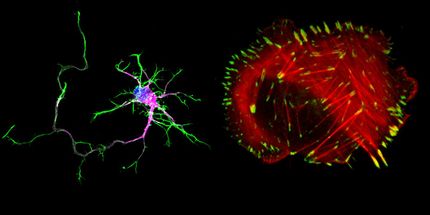Scientists identify new drug strategy against fragile X syndrome
Researchers at Emory University School of medicine have identified a potential new strategy for treating fragile X syndrome, the most common inherited cause of intellectual disability. The researchers have found that a class of drugs called phosphoinositide-3 (PI3) kinase inhibitors can correct defects in the anatomy of neurons seen in a mouse model of fragile X syndrome. In experiments with cultured neurons from the hippocampus the drugs could restore normal appearance and levels of protein production at synapses, the junctions between cells where chemical communication occurs. The results, published in the Journal of neuroscience, suggest that PI3 kinase inhibitors could help improve learning and cognition in individuals with fragile X syndrome.
"This is an important first step toward having a new therapeutic strategy for fragile X syndrome that treats the underlying molecular defect, and it may be more broadly applicable to other forms of autism," says senior author Gary Bassell, professor of cell biology and neurology at Emory University School of Medicine. He adds that his group has recently begun experiments in the mouse model to assess PI3 kinase inhibitors' effects on behaviors associated with fragile X syndrome.
The first author of the paper is postdoctoral fellow Christina Gross. Collaborators included Keqiang Ye, PhD, associate professor of pathology and laboratory medicine, and Stephen Warren, PhD, professor and chairman of human genetics.
While clinical trials in humans testing the effectiveness of another class of drugs, metabotropic glutamate receptor antagonists, against fragile X are well underway, Bassell says "the new approach may offer a different way to calm the overactive signaling, and also restore the glutamate receptor sensitivity that is lost in fragile X."
The genetic mutation responsible for fragile X prevents production of an RNA binding protein, FMRP, which regulates the production of many other proteins at synapses of brain cells. FMRP's absence leads to overactive signaling and protein production at synapses.
"The focus in the field has been on glutamate receptor antagonists," Bassell says. "The effects on glutamate receptor signaling are a big piece of fragile X, but they're not the only piece."
At their synapses, fragile X neurons produce proteins indiscriminately compared to unaffected neurons, he says. The "overexuberant" protein production leads to structural changes at their synapses, including a hyperabundance of dendritic spines. These spines are small protrusions that transmit electrical signals to adjacent neurons, and contribute to the communication between individual neurons in the brain.
Gross and Bassell discovered that in cells from mice where the FMRP gene has been deleted, the PI3 kinase enzyme is three times more active. PI3 kinase regulates protein synthesis in response to the electrochemical signals neurons send each other. The authors showed that tamping down PI3 kinase activity in fragile X neurons can restore normal levels of both protein synthesis and dendritic spine density.
PI3 kinase inhibitors are already under investigation for their anti-cancer properties, and some drugs of this type, such as wortmannin, can be toxic to normal cells. Bassell notes that this type of drugs would need to be used at low doses to only dampen excess signaling of protein production caused by fragile x. The drugs his team tested were effective in correcting fragile X molecular defects at levels five times lower than those usually employed, and did not reduce protein production in normal cells.
Bassell anticipates that drugs that preferentially inhibit the subtype of PI3 kinase present only in neurons hold greater promise as a novel therapeutic strategy. "A few of these subtype-specific drugs are already available for researchers, and we are involved in efforts to test these more specific drugs in the fragile x mouse model," he says.
Original publication: C. Gross, M. Nakamoto, X. Yao, C.B. Chan, S.Y. Yim, K. Ye, S.T. Warren and G.J. Bassell; "Excess phosphoinositide 3-kinase subunit synthesis and activity as a novel therapeutic target in fragile X syndrome."; J. Neurosci . 30: page #s (2010)..
Topics
Organizations
Other news from the department science

Get the life science industry in your inbox
By submitting this form you agree that LUMITOS AG will send you the newsletter(s) selected above by email. Your data will not be passed on to third parties. Your data will be stored and processed in accordance with our data protection regulations. LUMITOS may contact you by email for the purpose of advertising or market and opinion surveys. You can revoke your consent at any time without giving reasons to LUMITOS AG, Ernst-Augustin-Str. 2, 12489 Berlin, Germany or by e-mail at revoke@lumitos.com with effect for the future. In addition, each email contains a link to unsubscribe from the corresponding newsletter.



















































